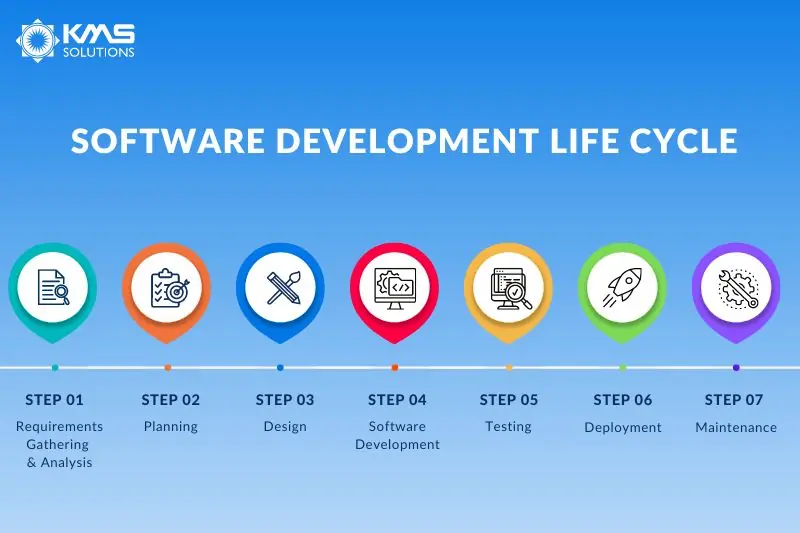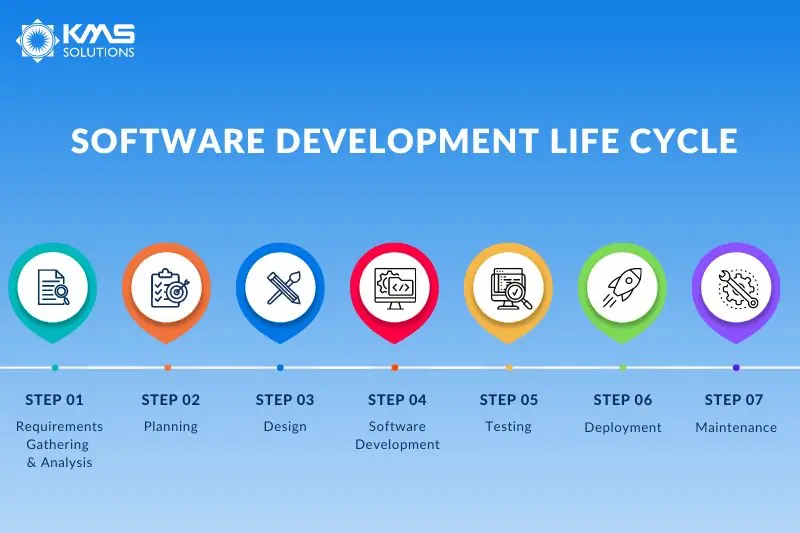Software creation is no easy task. Hence, you would need to design a Software Development Life Cycle (SDLC) to circumvent obstacles in the implementation process. Let’s explore the different phases to start a successful software development project.
What is the Software Development Life Cycle (SDLC)?
The Software Development Life Cycle, or ‘SDLC’, is a rigorous, iterative, multistage process that clearly outlines the stages involved in the software development project. Having a proper framework will enable businesses to deliver a robust system that meets the customers’ expectations.
As it includes a detailed plan for each stage of creating software, adhering to the SDLC process results in the development of it in a systematic and disciplined manner.
Here’re key reasons why SDLC is essential for creating a software system:
-
- It provides a foundation for project planning, scheduling and estimating.
- Increases the visibility of project planning to all relevant development process stakeholders.
- Helps accelerate and improve development
- It is a system for managing and tracking the progress of projects.
- Helps achieve the highest level of transparency and management control.
- Decrease project risk and improve development speed.
How to start a software project?
An SDLC describes each stage of the software development cycle, breaking down the process into a variety of separate steps: goals, expectations, tasks, process instructions, documentation, deliverables, and go-to personnel.
The precise number and characteristics of steps depend on the company and its product objectives. Each phase in an SDLC results in an output that serves as the prerequisite for the following step.
In most cases, the software development life cycle consists of 7 phases.

1. Requirements Gathering & Analysis
Purpose: This is where teams examine the requirement analysis with inputs from clients, the sales department, market research reports and subject matter experts. For instance, a banking mobile app would require eKYC for the digital onboarding process and digital lending platforms covering the entire loan lifecycle.
Some critical questions during this phase that you can consider include:
-
- What is the objective?
- What are the main results that companies hope to get from the product?
- Is it developing a new software project or upgrading an existing one?
- Do we have any deadlines that need to pay attention to?
- Do we use the internal development team, or will we have to outsource some part(s) of the project?
The person mainly in charge: Business analysts (BA).
The requirements collected by BA will need to get approval from either the customer or the market analysts via a Software Requirement Specification (SRS), which contains both functional and non-functional requirements to be developed throughout the project lifecycle.
Output: The SRS documents that defined the project’s specific objectives and needs will then be used as a point of reference for the next stage.
The SRS will need to include all the software, hardware, security, and specifications needed.
2. Planning
Purpose: Once gathering requirements is completed, the next step is to plan. From there, the terms of the project will be determined:
- Cost estimation
- Required resources
- Tech stack
- Roles needed in the project
- Project scheduling
- Leadership structure
The person mainly in charge: Team Leaders and Higher Management
Project managers will need to clearly outline the project’s scope and objective. This charts the team’s trajectory to efficiently develop the software. Additionally, it establishes constraints to prevent the project from escalating or deviating from its initial objective.
Output: An expanded SRS document with product feasibility analysis and risk identification.
Based on this outcome, you can define the appropriate technical methods that should be implemented for the project to run smoothly with minimum risks.
3. Design
Purpose: The third phase goes into great detail about the required standards, features, and activities that fulfil the functional specifications of the proposed system.
Some essential factors that you need to take into account:
- Architecture: quality attributes, IT environment, human dynamics, and business strategy.
- User Interface: how users interact with the software.
- Platforms – decide on which platform the software will launch (Windows, Android, iOS, and Macintosh).
- Programming: involves techniques of resolving issues and executing tasks in the app alongside the programming language.
- Communications: specifies the channels through which the software can talk to other assets, e.g. a central server.
- Security: describes the procedures taken to safeguard the program, which might consist of password protection, SSL traffic encryption, and secure user credential storage.
During this SDLC step, a prototype is worth considering. Although it is time-consuming, prototyping will be much more affordable than making significant modifications after the software development phase.
The person mainly in charge: Architects and Senior Developers
A person who is responsible for this will gather this info in the Design Document Specification (DDS). Stakeholders then will examine the DDS based on the software’s risk assessment, design modularity and time constraints.
Output: A detailed DDS that lists all the information required to code the product.
4. Software Development
Purpose: This phase of SDLC involves writing code and transforming design documentation into actual software. Tools like Access Control or Source Code Management might be used to keep track to code changes.
The person mainly in charge: Developers
The developers’ team should make sure that their code adheres to the planned blueprint to meet the software requirement specifications. It’s also important that you have clear instructions about the code practices and style.
Output: Source code of a testable, fully functional software.
5. Testing
Purpose: This stage of SDLC helps ensure the software has no bugs or exploits and can run smoothly.
Businesses have various testing strategies to evaluate the new product, including
- Performance testing
- Security testing
- Unit testing (functional tests)
- Automation testing
- Integration testing.
When the product is stable, bug-free, and up to the quality criteria outlined in the earlier stages, the testing step is complete.
The person mainly in charge: Quality Assurance (QA) specialists.
QA engineers usually deploy a range of frameworks in addition to continuous integration to perform unit tests and automation compilation. Testers will need to have a combination of manual and automated testing knowledge and skills to perform the tests effectively,
Output: A thoroughly tested version of the product ready for a production environment.
6. Deployment
Purpose: Depending on the client’s requirements, the product might undergo User Acceptance Testing (UAT) where it is tested in a real business environment with a limited segment. Most businesses deploy their new products to a small percentage of users (10-15%) and slowly release them to the rest of the customer base.
The person mainly in charge: Project Managers
Output: The release of a fully functional and tested product.
7. Maintenance
Purpose: The final SDLC phase entails maintenance and regular upgrades. This stage concentrates on keeping the software safe, increasing performance, and occasionally adding new features.
The person mainly in charge: Production support engineers, testers, and developers.
Output: A fully monitored software that’s constantly requiring improvements
Read more: Software Quality Services for Financial Institutions
What is the most important phase of SDLC?
Requirements gathering and analysis is the most crucial stage of the SDLC cycle. Without understanding the requirements, no project team can create a solution that is appreciated by customers. Most teams put effort into developing new solutions and neglecting requirement gathering which results in the failure of the software projects. This is one of the main reasons driving 66% of software projects to fail, as per the Standish Group’s 2022 CHAOS report. Hence, it’s crucial that each requirement is outlined in detail and understood by the development team.
SDLC Models
There are multiple SDLC models you can implement for your projects. Popular SDLC models are:
-
- Waterfall model: The Waterfall model is a linear and sequential approach to software development and project management. This approach requires careful planning and documentation at the beginning of the project. Then, people will rigidly follow.
- Agile: The Agile model is an iterative approach to software development that emphasizes flexibility, collaboration, customer feedback, and continuous improvement. It breaks tasks into short prints to deliver small, functional pieces of software quickly.
- Lean Software Development: This is an agile framework focused on maximizing development efficiency by optimizing time and resources and removing unnecessary elements, ultimately delivering only what the product requires. This approach is often associated with the MVP strategy, where a team launches a basic version of the product to the market
- Scrum: This methodology provides a structured yet flexible approach that promotes teamwork, accountability, and continuous improvement. Scrum helps teams deliver value to customers iteratively and incrementally, ensuring that they can adapt to changing requirements and feedback.
Best Practices of SDLC

Source Control
Development teams often use Source Control as a security strategy to protect the working code by storing the code in a single place with secured and logged access. It can either be a physical site where files are kept and retrieved in a room or a virtual area where customers can log in for a cloud-based programming environment via an encrypted channel.
Source Control is also equipped with a change management system that enables you to keep track of your team workflow. As with any storage, you should utilize a backup system to document development progress in case of a crisis.
Continuous Integration (CI)
The purpose of CI is to ensure every element is compatible throughout the development cycle. Before the emergence of CI, development teams would have to integrate thousands of lines of code at once. This posed tremendous problems, making the system prone to error. CI automates the incorporation of code change from various contributors to a single software. This helps avoid conflicts and duplicated work by ensuring all teams deploy the same programming languages and libraries.
SDLC Management Systems
An SDLC management system monitors and manages each phase of the development cycle. It enhances the transparency of each stage and the project as a whole. Analytics, and bug-tracking are also included. The cycle’s inefficient components can be optimized using these measures.
Conclusion
Having an effective SDLC is vital to develop a high-quality software solution. Failure in one stage can have negative effects on the remaining stages of the cycle, hence, jeopardizing the success of the project. Businesses can only take advantage of SDLC when the plan is meticulously followed.
Want to design an efficient SDLC that can streamline the software development cycle and create transformative products? Consult with our experts today to kick-start your project and have professionals accompany you through every stage of the SDLC.











